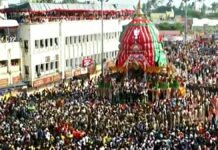
Puri: Like every year, this year also the wood brought for the chariot of Lord Jagannath in Odisha was worshiped on the day of Basant Panchami. But this time this wood did not come from the forests, but it was taken from private land. The wood used in the chariot of Lord Jagannath is from a special tree called Phasi (Anogysis acuminata) and Dhaura. Due to the significant decline in this tree in the past years and due to climate change, wood could not be available this time in the chariot to be built for Jagannath Rath Yatra. According to the news published in Down to Earth, this year 99 percent of Dhaura and Fasi wood has been taken from private landowners. They were cut from the Nayagarh and Khorda districts of Odisha.
What happens dhaura
Apart from India, this tree, found in Nepal, Myanmar, and Sri Lanka, is very useful. The leaves of this tree, about 18-20 feet in height, are dense and the stem is white in color, hence it is called Dhaura. Many medicinal properties are found in it, as well as it is one of the most useful trees of India. Along with firewood, this tree is the main source of Indian gum. The gum obtained from it is called Ghatti Gum. It is used in calico printing. Not only this, but its leaves are also fed to the antheria puffia moth i.e. Tasar silkworm, from which the best quality silk is prepared.
How many wooden trunks are used in Jagannath Rath?
About 72 logs or stems of Dhaura are used to make the wheels of Jagannath Rath. The special thing is that this tree must be 14 feet tall and 6 feet wide. If the width is less than this then that tree is not used. Apart from Dhaura, chariots of Lord Jagannath, Balabhadra, and Subhadra are prepared every year from about 865 trunks of Asan and Simal and some other trees.

Climate change and Rath Yatra
Phasi trees are usually found in the alluvial flooded areas of Mahanadi. According to the Forest Department, due to climate change, forests have suffered a lot in the last few years. It takes about 50-60 years for a Fassi tree to mature. The trunk of the tree used for the chariot should be straight like a pencil. It should be 6 feet wide and 12-14 feet high. Since these trees take 50-60 years to mature, the plants in the forest are still in their infancy and cannot be cut. Apart from this, it is also necessary to leave some adult trees from which the plants can be found.
In such a situation, it has become a compulsion to take trees from private land for Jagannath Rath. The Forest Department is concerned about the rapid change in climate and unbalanced rains and storms. It takes about 80 years for a Dhaura tree to attain a width of 6 feet, while their growth has also been affected in the last two decades due to climate change. Now it will take about 100 years to reach its breadth. In such a situation, the Forest Department has started the exercise of planting these trees, for this, they formed the Jagannath Ban Project in the year 2000. Under which trees like Neem, Asan have been planted, but even then it is a bit difficult to plant trees like Fasi Dhaura, so it has been made mandatory for all private landowners to plant it.








































